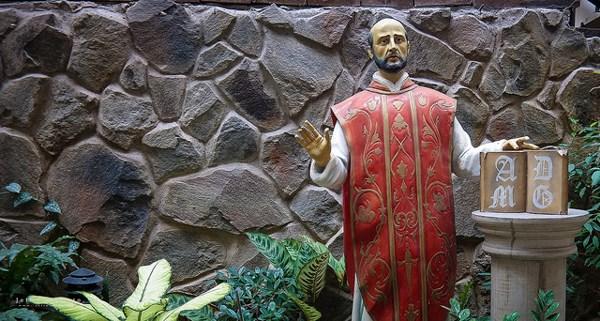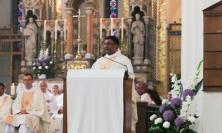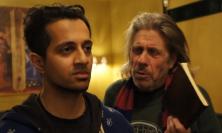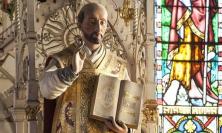The life of the saint whose feast we celebrate on 31 July was changed completely when he read the stories of the saints who had come before him. But tradition has it that Ignatius had a devotion to St Peter even before his conversion as a convalescent, and that it was Peter’s intercession that brought about his recovery. To mark Ignatius’s feast, Philip Endean SJ explores this tradition and how it may have played out, both in Ignatius’s own life and in the mission of the Society of Jesus ever since.
A few years before he died, Ignatius Loyola dictated his life story. He recalled how serious his injuries had been after the cannonball shattered his leg. On June 28, the vigil of the feast of St Peter and St Paul, the doctors told him that ‘unless he felt improvement by midnight he could be counted as dead’, and he received the sacraments. But then healing came. As Ignatius’s own dictated narrative puts it, ‘the said patient had a regular devotion to St Peter, and so Our Lord willed that that same midnight he should begin to find himself better.’
Peter and the Church
‘A regular devotion to St Peter’. There is no hint of this detail in any of the earlier documents about Ignatius’s life, but Peter’s role in Ignatius’s recovery soon became part of the biographical tradition. In his full-dress Latin biography published a few years after Ignatius’s death, Pedro de Ribadeneira explicitly speaks of ‘the direct intervention of Divine Providence and Saint Peter’s intercession’. In a Spanish version, he comments that Ignatius had always had Peter ‘as a particular patron and advocate, and as such had reverenced and served him’. When a few years later, Juan de Polanco, who had served as Ignatius’s secretary for the last nine years of his life, repeated the substance of Ribadeneira’s account, he added another detail: the youthful Ignatius had even venerated Peter with Spanish hymns composed in his honour.
In this year of 2017, the Reformation jubilee reminds us of a sharp polemical significance that may be informing Ignatius’s recollection of his healing, and of St Peter’s role in it. Though Luther’s rupture with the Church centred originally on the theology of grace and on the abusive practice of indulgences, it had quickly broadened to a bitter rejection of papal authority as such. In his trenchant treatise on the sacraments, The Babylonian Captivity of the Church, written in 1520, Luther complains that ‘the Roman pontiff with his despotism’ has betrayed the freedom that comes from dying and rising with Christ in baptism. Instead of preaching and defending this liberty, and teaching the gospel of justification by faith alone, ‘he seeks only to oppress us with his decrees and his laws, and to enslave and ensnare us in the tyranny of his power’.
Against such a background, one can easily understand why one respected commentator on Ignatius’s Autobiography claims that Ignatius’s devotion to St Peter, which predates what he presents as his conversion, ‘is not to be understood as a devotion to just any old saint’. Rather, it says something quite emphatic about a devotion to the Church, for which ‘St Peter even in the Middle Ages was understood and venerated’ as a representative figure – a devotion only intensified by the struggle of Christians against the Moors in Spain. Ignatius’s mature achievement, ‘the founding of his order that would be wholly at the Pope’s disposal’, has its roots in an instinctive attitude going deeper than any formal theology. Though Ignatius throughout his life had to struggle with authority figures in the Church lacking sympathy with his project, and accusing him all too easily of illuminist heresy, he was always a man of the Church. His movement may have represented some version of reform, but never protest. For all the tensions he had to live with, Ignatius’s life within the Church was always, and impressively, an unquestioned given.
The other reference to St Peter in Ignatius’s Autobiography reinforces the point. In Paris, Ignatius was short of money, and he thought of offering himself as paid help to one of the teachers. He tells us that he found consolation in imagining the master as Christ, and the various students as the apostles – Peter, John and so on. He continues revealingly: ‘and when the master commands me, I’ll think that it’s Christ who’s commanding me, and when someone else commands me, I’ll think it’s St Peter who’s commanding me.’ Peter is not simply one disciple among others. He also commands.
Growing in devotion
But Ignatius’s devotion to Peter nevertheless involved something more than respect for order and authority. Peter was important, not so much because he represented an authority to be defended against its critics, but rather because he provided the foundation on which new forms of church life could be securely built, manifesting new and greater divine glory. Perhaps it is significant that in the Autobiography, Peter appears, discreetly and simply, as Ignatius is healed, before the other saints come on the scene. Perhaps Peter represents a tacit, traditional foundation for the daydreams, and for the discernment between them, that come later, with Ignatius's convalescence.
As another commentator on the Autobiography has noted, Peter’s presence at Ignatius’s healing seems to emerge from a devotion centred on exterior practices and cults, and on a God whose providence is found in particular events conceived as momentary divine interventions. But by the time the text was dictated, Ignatius was operating differently. When he recalls his aggressive reaction, shortly after leaving Loyola, to a Moor questioning Mary’s perpetual virginity, he comments that he was not yet ‘considering anything within himself, nor knowing what humility was, or charity, or patience, or discernment in regulating and balancing these virtues’. Gradually Ignatius’s religion had become more interior. At the end of the Autobiography, ‘devotion’ meant a habitual facility in finding God, whatever the situation. ‘(E)very time and hour he wanted to find God, he found him.’
Ignatius’s devotion did not stay still. His apostolic project could only exist in change, in interaction, in relationship. ‘La Compagnia si può dire solamente in forma narrative’ – as Pope Francis, who is obviously uniquely placed to speak of Peter’s role in Ignatian spirituality, put it during his celebrated interview with Antonio Spadaro in August 2013. Talk about the Society of Jesus and its charism – whether what others say of it or how it imagines itself – must take a narrative form. If you do not get beyond philosophical and theological discussion, if you are content with abstractions such as ‘devotion to Peter’, you miss important points.
On matters of authority and obedience in general, and on papal devotion in particular, Ignatius’s thought can easily seem contradictory. We can find a revealing pair of examples in his letters. Writing to the king of Ethiopia, in the context of an attempt to bring him within the Western church, Ignatius is uncompromising on Rome’s authority. The patriarch in Alexandria or Cairo is like ‘a limb severed from the body’. ‘The Catholic Church is but one throughout the whole world; there cannot be one church under the Roman pontiff and another under the Alexandrian. As Christ her bridegroom is one, so his spouse the Church is one.’ Contrast this with the instruction Ignatius gave to the first Jesuits to be sent as a group to Germany, to the effect that they should avoid losing credibility ‘as papiste (Ignatius coins an Italian word in the middle of a Latin text), through ill-judged partisanship’. Their ‘zeal in countering heresy’ must rather be such as ‘to reveal love for the heretics themselves and a compassionate desire for their salvation’. How can the same man have written both letters?
Ignatius’s loyalty to Peter and the Church may never have wavered, but it was constantly deepening and broadening. It was chiefly expressed through service and mission, and thus its expressions took different forms in different contexts. There was always a greater divine glory that could be imagined. Explaining the Jesuit’s vow of special obedience to the pope for mission in the Constitutions, Ignatius is direct: ‘The intention of the fourth vow pertaining to the pope was not to designate a particular place but to have the members distributed throughout the various parts of the world’. Whenever Jerónimo Nadal, sent by Ignatius around Europe to explain the Jesuit way of life, evoked St Peter’s role in Ignatius’s healing at Loyola, he encouraged in his hearers not only a devotion to Peter but also to Paul, the missionary. Nadal may have been elaborating on his source, but he was doing so in a way that fully respected its spirit.
The centre and the horizon
As Pope Francis put it in the Spadaro interview, a Jesuit’s centredness in Christ and in the Church makes sense only if this enables him to look ‘at the horizon towards which he must go’. A true devotion to the centre leads us to become ‘searching, creative and generous’. Being a ‘contemplative in action’ amounts to a twofold ‘profound closeness’: both to ‘holy mother the hierarchical church’, and to the experience of the people of God on the peripheries.
‘It is difficult to speak of the Society’, says Pope Francis. Its central commitments to Christ and the Church are expressed through service and mission to others. The theories are set within a context of narratives – narratives recounting the immediate and ever different dealings of God with God’s people. The process is guided by an ‘aura mystica’ that ‘never defines its borders or completes its thought’. It requires us to be people ‘of incomplete thought, of open thought’. Living as a loyal Catholic Christian with this sort of commitment can lead to painful tensions. Pope Francis refers to the difficulties he himself experienced as a Jesuit in this regard. For his part, the theologian Karl Rahner, adopting the persona of Ignatius speaking to a contemporary Jesuit, evoked the ‘miracle’ of how the same Society can be both radically charismatic and at the same time profoundly united with the institutional Church. ‘You must try to bring about the miracle of this identification over and over again. The sums will never work out. But keep on trying to do it. One of the two on its own isn’t enough. Only the two together are enough to crucify you.’
Peter missioning
One final text from the early Jesuits. Speaking to the community in Alcalá in 1561, Jerónimo Nadal was developing the analogy between the new Society of Jesus and the Lord’s disciples being sent out on mission. Before the gospel had been written, the disciples had lived by tradition; the first Jesuits, prior to the writing of the Constitutions had lived in the same way, without a written text. Ignatius, speaking to his companions, had used words of St Peter: ‘you know, brothers, our way and order of life; therefore, as you go, act that way’.
There is no record in Scripture of Peter saying anything like this. The quotation thus reveals the workings of the early Jesuits’ own spiritual imaginations. Prior to written constitutions, they lived from a deep intimacy and companionship among themselves, no doubt firstly with Christ, but now nevertheless with Peter representing him. In one sense that way and order of life contains within itself everything that Jesuit disciples need. That life requires them to live euntes – in going out. To borrow from Jorge Mario Bergoglio in his speech at the consistory before the 2013 conclave, it is as though there is a Christ knocking at the door from within his disciples and within the Church, bidding us to let him come out. This is the Christ of whom Peter is the vicar, or representative. And if the Church keeps that Jesus within itself, it becomes ‘self-referential and sick’.
Philip Endean SJ is Professor of Spirituality at Centre Sèvres, Paris.
References
Besides the hyperlinks, see Ignatius’s Autobiography, nn. 3, 75, 14, 99 – commentaries by Burkhard Schneider and Antoine Lauras; Ribadeneira in Claude Pavur’s ET, pp. 12-13, Spanish in FN 4.85; Polanco in FN 2.517 – the Latin is ambiguous as to whether Ignatius himself did the composing. The English translation of Pope Francis’s interview is worth comparing with the Italian original. The two Ignatian letters cited (24/9/1549; 16/2/1555) can be found in standard selections. Constitutions VII.1.B [605]; Jerónimo Nadal in MN 5.268, 5.245-46.






